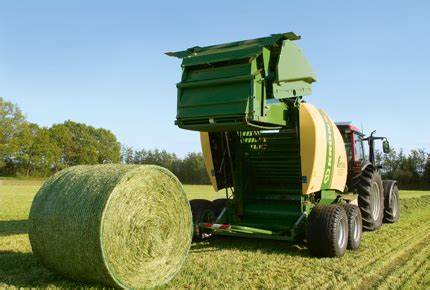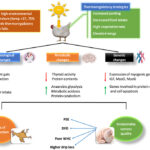
1. Introduction
Forage conservation is the process of harvesting and preserving forage crops to ensure their availability and nutritional quality during periods when fresh forage is scarce or unavailable. In commercial livestock operations, consistent and high-quality feed supply is essential for:
- Sustained milk and meat production,
- Animal health and reproduction,
- Economic efficiency and profitability.
Forage conservation plays a vital role in buffering seasonal feed shortages and stabilizing livestock productivity throughout the year.
2. Importance of Forage Conservation in Commercial Systems
- Mitigates seasonal fluctuations in forage availability (e.g., during dry seasons or winter).
- Ensures feed security, especially during natural disasters (droughts, floods).
- Supports intensive systems (e.g., dairy farms, feedlots) where grazing is limited or not feasible.
- Reduces feed costs by minimizing reliance on expensive commercial feeds during lean periods.
- Improves nutrient utilization by preserving forages at their optimum growth stage.
- Facilitates bulk buying and long-term storage, making feed supply more predictable and manageable.
3. Common Methods of Forage Conservation
A. Silage Making
Definition:
Silage is fermented, high-moisture forage stored under anaerobic conditions to preserve nutrients through lactic acid fermentation.
Suitable Forages:
- Maize, sorghum, Sudan grass, Napier grass, alfalfa, legumes.
Key Steps:
- Harvesting at optimal stage (milk to dough stage for maize/sorghum).
- Chopping forage to 1–2 cm pieces for proper compaction.
- Ensiling in silos, bunkers, pits, or silage bags.
- Compacting thoroughly to remove air and sealing airtight.
- Fermentation period of 21–30 days.
Advantages:
- High palatability and digestibility.
- Preserves forage for 6–18 months.
- Allows harvesting during surplus and use during deficit.
Challenges:
- Requires infrastructure and initial investment.
- Risks of spoilage if poorly sealed or compacted.
B. Hay Making
Definition:
Hay is dry forage obtained by drying grasses or legumes until moisture content is reduced to 15–18% for safe storage.
Suitable Forages:
- Grasses: Bermuda grass, Guinea grass, Rhodes grass.
- Legumes: Alfalfa, Lucerne, clover.
Key Steps:
- Harvesting before flowering (to ensure optimal nutrient content).
- Drying in the sun (can use mechanical dryers in humid climates).
- Turning for uniform drying and to avoid mold.
- Baling and storage in dry, ventilated barns.
Advantages:
- Easy to store and transport.
- Low-cost preservation method.
- Suitable for areas with long dry seasons.
Challenges:
- Weather-dependent during drying.
- Nutrient losses if over-dried or rained on.
C. Urea Treatment of Crop Residues
Used For:
- Wheat straw, rice straw, maize stover, sugarcane tops.
Process:
- Spray 4% urea solution on chopped straw.
- Store under airtight conditions (e.g., plastic-covered pits) for 1–3 weeks.
- Ammonia generated improves digestibility and crude protein.
Benefits:
- Converts low-quality residues into usable feed.
- Increases voluntary intake and rumen fermentation efficiency.
D. Feed Block and Total Mixed Ration (TMR) Production
Feed Blocks:
- Compressed mixtures of chopped roughage, molasses, urea, minerals, and binders.
TMR:
- Uniformly mixed combination of forages, grains, minerals, and additives.
- Fed ad libitum to cattle in feedlots and dairy farms.
Advantages:
- Complete and balanced nutrition.
- Reduces feed sorting and waste.
- Ensures uniform intake of nutrients.
4. Forage Conservation Infrastructure in Commercial Operations
To scale conservation practices for commercial success, the following infrastructure is essential:
1. Silage Units:
- Silage bunkers, tower silos, trench silos, or mobile silage bags.
- Ensures hygienic, airtight storage and minimal wastage.
2. Hay Sheds and Baling Machines:
- Roofed sheds for dry storage.
- Mechanized mowers, tedders, and balers improve efficiency.
3. Feed Processing Units:
- Equipment for grinding, mixing, and pelleting roughage and supplements.
4. Transportation and Packaging:
- Use of silage bags, hay bales, and TMR pellets for efficient on-farm or market delivery.
5. Best Management Practices (BMPs) in Forage Conservation
- Harvest at correct stage to maximize nutrient content.
- Maintain hygiene to prevent spoilage from mold or pathogens.
- Monitor moisture content (too high → spoilage; too low → nutrient loss).
- Ensure airtight sealing in silage to prevent aerobic spoilage.
- Train workers in conservation techniques, quality control, and safety.
6. Quality Control Measures
- Regular sampling of conserved feed for:
- Dry matter (DM) content
- Crude protein (CP)
- Fiber fractions (ADF, NDF)
- pH and ammonia nitrogen (in silage)
- Mold and toxin screening (especially in silage and stored hay).
- Labeling and record-keeping of forage types, harvest dates, and nutrient analysis.
7. Economic Considerations
- Cost-benefit analysis of forage conservation vs. buying commercial feed.
- Bulk harvesting and storage during peak seasons lowers cost per unit of feed.
- Value addition through enrichment (e.g., molasses, urea, minerals) improves profitability.
- Sale of surplus conserved forage to other farmers or feedlots can be a revenue stream.
8. Conclusion
Forage conservation is a cornerstone of successful commercial livestock production, enabling consistent feed availability, cost control, and improved productivity. By integrating advanced conservation methods like silage, hay, urea treatment, and feed blocks, along with proper storage, quality control, and training, farmers can transition toward resilient, efficient, and profitable animal husbandry systems. Strategic forage conservation not only enhances farm profitability but also contributes to national food security by stabilizing livestock-based outputs year-round.




Laiba Hafeez
Reg no : 23-Cuvas-0298
DVM 4th semester
23-CUVAS-0337
DVM (4th Semester)
Suffian Haider
23cuvas0319
23-cuvas-0321
23-CUVAS-0306
23-cuvas-0295
Preetam Raam
23-CUVAS-0334
DVM 4th
Excellent information about conservation of forages
23- Cuvas – 0307
23-cuvas-0300
Very convenient way of study
Reg#:23-CUVAS-0312
DVM 4TH
23-cuvas-0314
Waseem saleem
23-cuvas-0326
Talha Waheed
23-CUVAS-0305
DVM 4 semester
23-cuvas-0331
23-cuvas-0321
23-cuvas-0300
Abdullah Sharif 23-Cuvas-0332 DVM 4th semester
Laiba Hafeez
Reg no : 23-cuvas-0298
Very convenient way of study hi
Muhammad Ibrahim
23-cuvas-0299